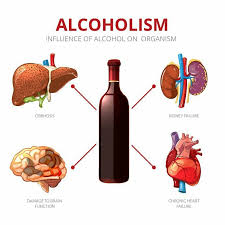
Humans have been drinking alcohol for thousands of years. Alcohol is both a chemical and a psychoactive drug. In chemistry, an alcohol exists when a hydroxyl group, a pair of oxygen and hydrogen atoms, replaces the hydrogen atom in a hydrocarbon. Alcohols bind with other atoms to create secondary alcohols. These secondary alcohols are the three types of alcohol that humans use every day: methanol, isopropanol, and ethanol.
Different Types of Alcoholic Drinks By Alcohol Content
There are many different kinds of alcoholic drinks, and some of them contain more alcohol than others. The types of alcoholic drinks with higher concentrations of alcohol are able to cause drunkenness and alcohol poising more quickly and in smaller doses.
Whiskey : Whiskey is a spirit made from fermented grain. The ABV of whiskey ranges from 40% to 50%.
Rum : Rum, a distilled drink made from fermented sugarcane or molasses, has a typical alcohol concentration of 40% ABV. Some rum is “overproof,” meaning that it has alcohol concentration of at least 57.5% ABV. Most overproof rum exceeds this minimum, usually reaching 75.5% ABV, which is equivalent to 151 proof.
Tequila : Tequila is a type of liquor. The main ingredient of tequila is the Mexican agave plant. The alcohol concentration of tequila is typically about 40% ABV.
Vodka : Vodka, a liquor usually made from fermented grains and potatoes, has a standard alcohol concentration of 40% ABV in the United States.
Pros and cons of moderate alcohol use : Moderate alcohol consumption may provide some health benefits, such as:
- Reducing your risk of developing and dying of heart disease
- Possibly reducing your risk of ischemic stroke (when the arteries to your brain become narrowed or blocked, causing severely reduced blood flow)
- Possibly reducing your risk of diabetes
However, eating a healthy diet and being physically active have much greater health benefits and have been more extensively studied.Keep in mind that even moderate alcohol use isn’t risk-free. For example, even light drinkers (those who have no more than one drink a day) have a tiny, but real, increased risk of some cancers, such as esophageal cancer. And drinking and driving is never a good idea.
Risks of heavy alcohol use : While moderate alcohol use may offer some health benefits, heavy drinking — including binge drinking — has no health benefits.Heavy or high-risk drinking is defined as more than three drinks on any day or more than seven drinks a week for women and for men older than age 65, and more than four drinks on any day or more than 14 drinks a week for men age 65 and younger.
Binge drinking is defined as four or more drinks within two hours for women and five or more drinks within two hours for men.Excessive drinking can increase your risk of serious health problems, including:
- Certain cancers, including breast cancer and cancers of the mouth, throat, esophagus and liver
- Pancreatitis
- Sudden death if you already have cardiovascular disease
- Heart muscle damage (alcoholic cardiomyopathy) leading to heart failure
- Stroke
- High blood pressure
- Liver disease
- Suicide
- Accidental serious injury or death
- Brain damage and other problems in an unborn child
- Alcohol withdrawal syndrome
If you don’t drink alcohol, don’t start because of potential health benefits. However, if you drink a light to moderate amount and you’re healthy, you can probably continue as long as you drink responsibly. Be sure to check with your doctor about what’s right for your health and safety.

Arushi Kapoor always rocks in every topic⭐⭐
LikeLiked by 2 people